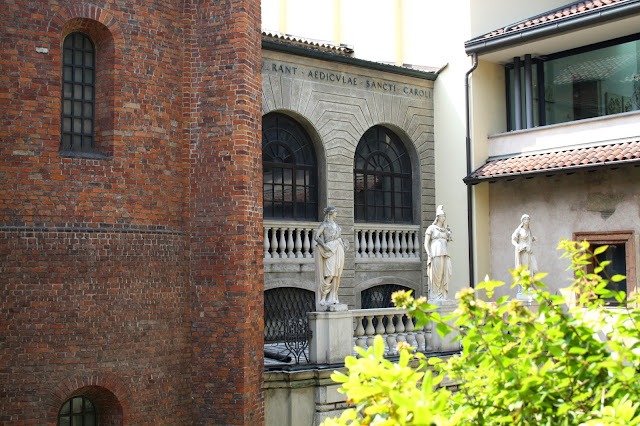„Najbardziej zachwyciła mnie kolekcja rękopisów” - Lord Byron w Pinakotece Ambrozjańskiej/ “What has delighted me most is a manuscript collection" - Lord Byron in Pinacoteca Ambrosiana
W październiku 1816 roku Lord Byron spędził trzy tygodnie w
Mediolanie (o którym piszę tutaj). W tym czasie kilkakrotnie odwiedził muzeum i bibliotekę ambrozjańską.
Pinacoteca Ambrosiana została założone w 1618 roku przez Fryderyka Boromeusza. Muzeum
gromadzi bezcenne zbiory malarstwa (np. Caravaggia, Boticellego, Tycjana) i rękopisów (m.in. Leonarda da Vinci).
In October
1816 Lord Byron spent three weeks in Milan (you can read about it here)
Byron uparcie twierdził, że nie zna się na malarstwie. Tym, co go zafascynowało były rękopisy listów między Lukrecją Borgią a Pietrem Beppo.
„Byłem w bibliotece ambrozjańskiej – to bardzo piękna kolekcja,
pełna rękopisów – opracowanych i nieopracowanych (…) Najbardziej mnie
zachwyciła korespondencja między Lukrecją Borgią a kardynałem Bembo (tu
przechowywana). Ślęczę nad nimi i nad lokiem jej włosów – najładniejszym i
najdoskonalszym z możliwych – nigdy nie widziałem jaśniejszych – i będę tam
chodził żeby czytać te listy w kółko i będę próbował zdobyć część tych włosów
uczciwie – już przekonałem bibliotekarza. Obiecał mi także kopię
tych listów - mam nadzieję, że mnie nie zawiedzie. Są krótkie, ale bardzo
proste i zwięzłe – jest też kilka wersów po hiszpańsku pisanych jej ręką” –
pisał w liście do Johna Murraya.
Byron insisted that he know nothing of painting.What fascinated him were the manuscripts of letters between Lucrezia Borgia and Pietro Beppo.
“I have been to the Ambrosian
library – it is a fine collection – full of M.S.S. edited & unedited (…) I
have been most delighted with a correspondence of letters all original and amatory
between Lucretia Borgia & Cardinal Bembo (preserved there ) I have pored
over them and a lock of her hair – the prettiest and finest imaginable – I
never saw fairer – and shall go repeatedly to read the epistles over and over –
and if I can obtain some of the hair by fair means – I shall try – I have
already persuaded the <help> librarian to promise me copies of the
letters – & I hope he will not
disappoint me. – They are short – but very simple & to the purpose – there
are some copies of verses in Spanish also by her” – he wrote to John Murray.
D. Dossi, Lucretia Borgia, 1518
R. Sanzio, Pietro Bembo, 1504
O listach napisał także do siostry Augusty:
„Najbardziej
zachwyciła mnie kolekcja rękopisów (przechowywana w Bibliotece Ambrozjańskiej)
oryginalnych listów miłosnych i wierszy Lukrecji Borgii i kardynała Bombo; i
lok włosów – tak długi i jasny i piękny – i listy są tak ładne i czułe –
że to sprawia, że człowiek nie może odżałować, że nie urodził się wcześniej, by móc
choć ją ujrzeć. I powiedz proszę, jak Ci się wydaje, co jest jednym z jej podpisów? Dlaczego ten + Krzyż, który ona
mówi, że „ma być jej imieniem”? Czy to nie zabawne? Przypuszczam, że wiesz, iż słynęła ona z
urody i z tego, że umiała zrobić z niej użytek; i że była miłością tego
kardynała Bembo (pomijając aferę z jej ojcem papieżem Aleksandrem i jej bratem
Cezarem Borgią – w którą niektórzy wierzą a inni nie), i że w końcu skończyła
jako księżna Ferrary i wspaniała matka, i żona też; tak wspaniała, że mogłaby
służyć za przykład. Wszystko to prawda albo i nie, ale te włosy i listy są tak
piękne, ze nie robię nic innego tylko ślęczę nad nimi…”
He also wrote about these letters to his sister
Augusta:
“What has delighted me most is a manuscript collection
(preserved in the Ambrosian library), of original love-letters and verses of Lucretia de
Borgia & Cardinal Bembo; and a lock of hair—so long— and fair & beautiful—and
the letters so pretty & so loving that it makes one wretched not to have
been born sooner to have at least seen her. And pray what do you think is one
of her signatures?—why this + a Cross—which she says “is to stand for her name &c.”
Is not this amusing? I suppose you know that she was a famous beauty, &
famous for the use she made of it; & that she was the love of this same Cardinal
Bembo (besides a story about her papa Pope Alexander & her brother Caesar
Borgia—which some people don’t believe—& others do), and that after all she
ended with being Duchess of Ferrara, and an excellent mother & wife also;
so good as to be quite an example. All this may or may not be, but the hair
& the letters are so beautiful that I have done nothing but pore over them.”
Skąd ta fascynacja listami? Jak wiadomo Byron był niezwykle czuły na wszelkie
przejawy pomieszania porządku poezji i rzeczywistości. A może spostrzegł
analogię miedzy relacją łączącą Lukrecję i Bembo a swoim związkiem z przyrodnią siostrą Augustą. Lukrecja była zamężna a Bembo był księdzem, w dodatku bliskim współpracownikiem jej męża. W 1502 roku połączył ich namiętny romans. Od tego czasu przez kilkanaście lat (do śmierci Lukrecji) prowadzili ze sobą korespondencję. Listy
XVI-wiecznych kochanków przesiąknięte są miłością nieoczywistą, niejednoznaczną
i niemożliwą, ale jednocześnie niezwykle autentyczną, głęboką, szczerą i oporną
upływowi czasu. Miłością zupełnie nieznaną XIX wiekowi, bo pozbawioną
romantycznej pozy i głośnych westchnień sentymentalizmu.
Where does this fascination with the letters come from? As it is known, Byron was extremely
sensitive to all signs of confusion in the order of poetry and reality. Or
maybe he noticed some analogy between the relationship between Lucrezia and
Bembo and his relationship with his half-sister Augusta
A lock of Lucretia's hair in a stand from 1928 by Alfred Ravasco
Już po
wyjeździe z Mediolanu Byron wyznał w liście do Moore’a: „Wziąłem sobie jeden
włos jako relikt i chciałem skopiować jeden lub dwa listy, ale jest to zakazane,
(…) więc nauczyłem się niektórych na pamięć”.
After he left Milan, Byron confessed in a letter to Moore: “I
took one single hair of it as a relic, and wished sorely to get a copy of one or
two of the letters; but it is prohibited; (…) and so I only got some of them by heart”.










Piękna i dziwna historia tych listów. I piękne jest to,że Byron uczył sie ich na pamięć...
OdpowiedzUsuńTo prawda. Dziś to trudne do uwierzenia, że ponieważ nie mógł ich przepaść to jedynym sposobem na ich utrwalenie było nauczenie się na pamięć.
Usuń